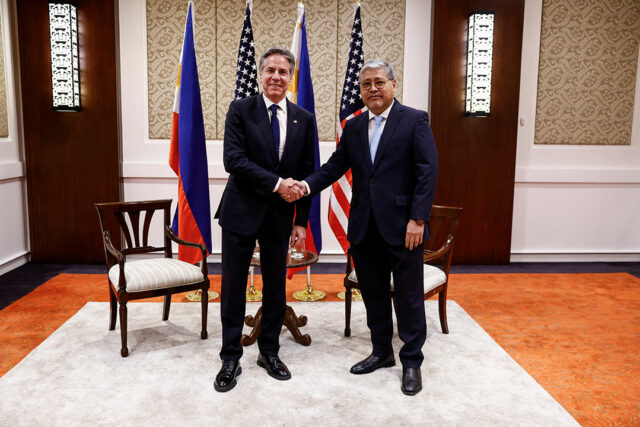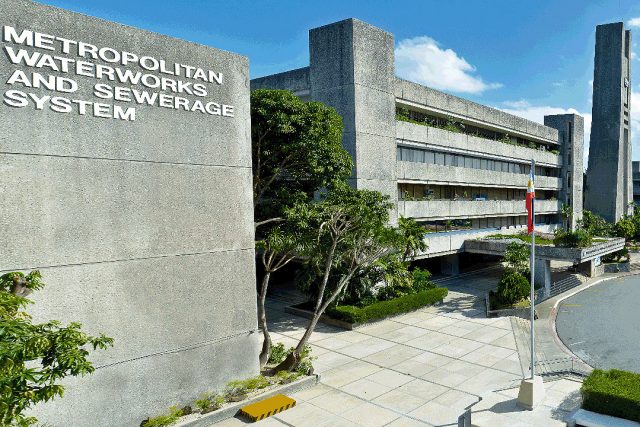By Kyle Aristophere T. Atienza, Reporter
US SECRETARY of State Antony Blinken on Tuesday said the United States stands by its “ironclad” commitments to defend the Philippines against an armed attack in the South China Sea.
“These waterways are critical to the Philippines, to its security, to its economy, but they’re also critical to the interests of the region, the United States and the world,” he said at a joint press conference in Manila with his Philippine counterpart Enrique Manalo.
Mr. Blinken said the 1951 Mutual Defense Treaty between the two nations extended to armed attacks on the Philippine armed forces, public vessels and aircraft, including those of its coast guard anywhere in the South China Sea.
He said defense ties with the Philippines were “extraordinary” and would only grow further, though Washington’s expanding alliances were not aimed at China.
Mr. Blinken said China’s actions in the South China Sea had triggered a wider international reaction, and the United States was engaged in intense diplomacy to reaffirm international law.
“We have a shared concern about (China’s) actions that threaten our common vision for a free open Indo-Pacific, including in the South China Sea and in the Philippines exclusive economic zone (EEZ),” he said.
During a meeting with Philippine President Ferdinand R. Marcos, Jr. later in the day, Mr. Blinken said US-Philippine ties are “more than rock solid” and an “absolute priority” of the Biden administration.
“I think Secretary [Manalo] said it so well: Our relationship is [on a] hyperdrive,” he told the Philippine leader, based on a press pool video. “That is so true, we see it across every domain.”
Last year, Mr. Marcos succeeded in pushing Washington to clarify the extent of the security commitment.
Mr. Blinken also said economic ties with the Philippines would expand, offering to support Philippine manufacturing as US companies diversify their supply chains.
Last week, the US Commerce secretary visited the Philippines and said US companies had pledged more than $1 billion in investments in the country.
Philippine Foreign Affairs Secretary Enrique Manalo said the challenge ahead was how to sustain and further elevate relations with the US, which he thanked for its support over recent altercations with China in the South China Sea.
The meeting came as the White House said President Joseph R. Biden would host Japanese Prime Minister Fumio Kishida and Mr. Marcos at a summit in Washington on April 11 to discuss economic ties and issues in the Indo-Pacific region.
Mr. Blinken said that arrangement was “a very important platform” for peace. “(It) is not designed against anyone, but in service of realizing a common vision for the future to the benefit of people in all of our countries.”
Ties between the Philippines and China have soured amid repeated spats over disputed features in the Philippine’s exclusive economic zone, and Manila has accused China’s coast guard of a policy of aggression.
Beijing, which claims sovereignty over almost the entire South China Sea, has maintained Philippine vessels are intruding into its territory.
China’s Foreign ministry spokesperson Lin Jian said the United States had no right to interfere in disputes between Manila and Beijing, and China would take action to defend its territory.
“Military cooperation between the United States and the Philippines should not harm China’s sovereignty and maritime rights and interests in the South China Sea, let alone be used to prop up the Philippines’ illegal position,” she told a news briefing.
The dispute coincides with a key improvement in military ties between the Philippines and United States in the past year, with Manila nearly doubling the number of its bases accessible to US forces, including three new sites facing Taiwan.
Their annual military exercises have widened lately to include joint air and sea patrols over the South China Sea and close to Taiwan, which China has seen as provocations.
Mr. Blinken’s remarks “further increase the Philippines’ confidence that the US will be there to support its claims in the South China Sea,” Gary Ador Dionisio, dean of the De La Salle University – College of Saint Benilde School of Diplomacy and Governance, said in a Facebook Messenger chat.
The Philippines is now one of the most visited countries in Southeast Asia by top American officials, he pointed out.
‘REAL MOTIVE’
The US sees the Philippines as a possible source of inputs, especially in semiconductors, as it boosts its manufacturing base while reducing dependence on China, Randy P. Tuaño, dean of the Ateneo de Manila University School of Government, said via Messenger chat.
“They should explore areas of commercial cooperation that will not only serve the interests of both sides but will provide the Philippines with more options amidst China’s ability to weaponize economics,” Don Mclain Gill, who teaches international relations at De La Salle University, said via Messenger chat.
Mr. Blinken’s return to Manila after almost a year was met with protests near the presidential palace, with groups accusing the US of fanning conflicts in the world.
“Today, our so-called main ally is actively fanning proxy wars and conflicts in various parts of the world,” Raymond Palatino, secretary-general of Bagong Alyansang Makabayan, said in a Messenger chat.
“The country’s assertion of sovereignty in the West Philippine Sea against China’s aggression should not involve the opportunistic meddling of a former colonizer whose real motive is to preserve and expand its imperialist hegemony in the Asia-Pacific region,” he added.
Joseph P. Purugganan, convenor of Trade Justice Pilipinas, sees the April 11 summit as “further consolidation of the Biden administration’s efforts to strengthen alliances to advance US economic interests and to sidestep China’s.”
He said the US is highly vulnerable to China’s access and control over critical raw materials that are vital to its manufacturing ambitions.
“It has to build these alliances, secure critical mineral agreements and enter into partnerships in order to ensure that supply chains that are vital to its interests are not disrupted and it can maintain advantage in manufacturing goods such as electric vehicles,” he said via Messenger chat.
The White House said Mr. Marcos and Mr. Biden would meet separately to “review the historic momentum in US-Philippine relations and discuss efforts to expand cooperation on economic security, clean energy, people-to-people ties, and human rights and democracy.”
“The increased anxiety of Japan regarding China and the Philippines’ reorientation back to the US against Chinese interests is a ripe opportunity for American foreign policy, and Washington would definitely like to have both on board,” Hansley A. Juliano, a political science lecturer at the Ateneo, said via Messenger chat. — with Reuters
















